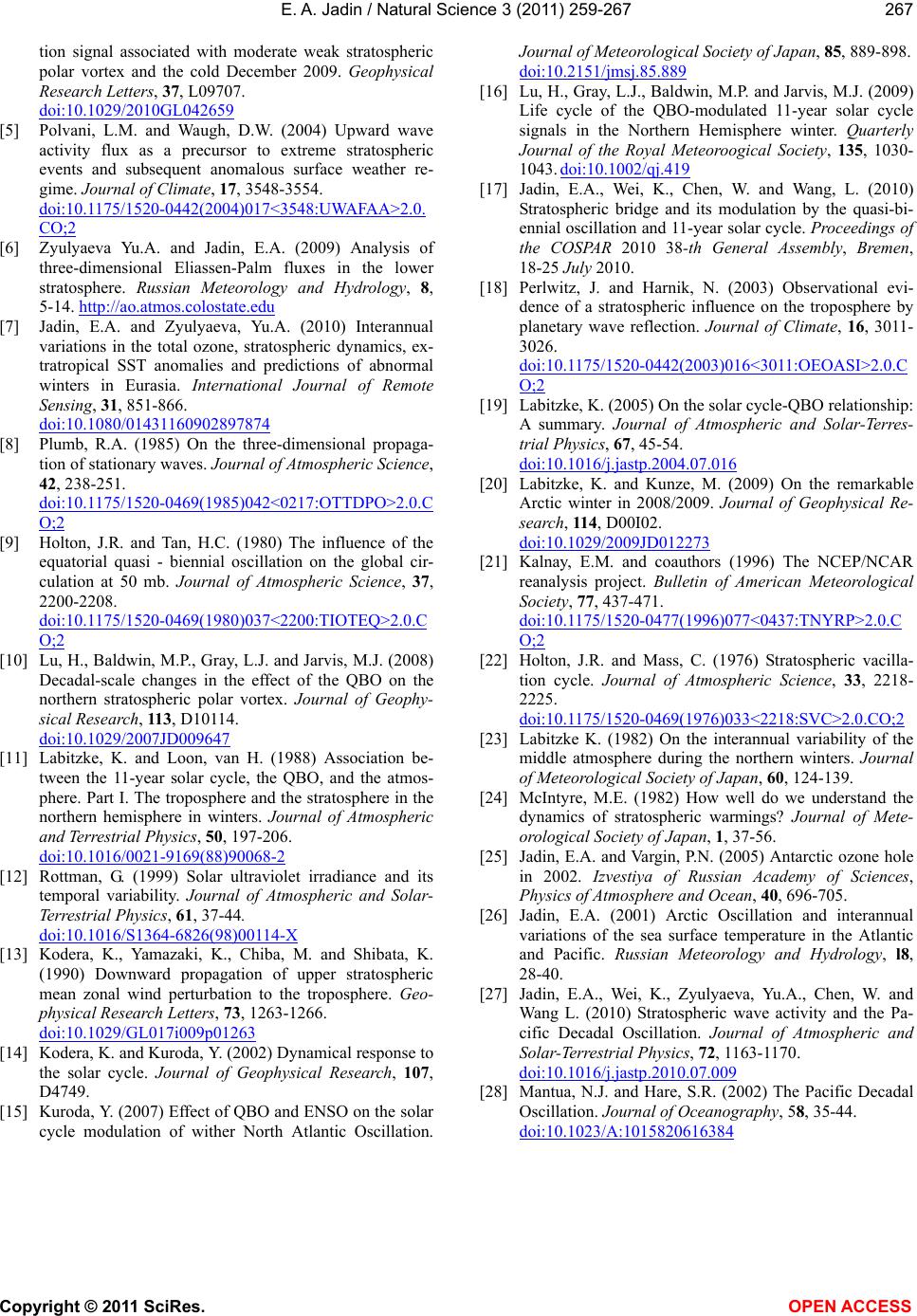
E. A. Jadin / Natural Science 3 (2011) 259-267
Copyright © 2011 SciRes. OPEN ACCESS
267
tion signal associated with moderate weak stratospheric
polar vortex and the cold December 2009. Geophysical
Research Letters, 37, L09707.
doi:10.1029/2010GL042659
[5] Polvani, L.M. and Waugh, D.W. (2004) Upward wave
activity flux as a precursor to extreme stratospheric
events and subsequent anomalous surface weather re-
gime. Journal of Climate, 17, 3548-3554.
doi:10.1175/1520-0442(2004)017<3548:UWAFAA>2.0.
CO;2
[6] Zyulyaeva Yu.A. and Jadin, E.A. (2009) Analysis of
three-dimensional Eliassen-Palm fluxes in the lower
stratosphere. Russian Meteorology and Hydrology, 8,
5-14. http://ao.atmos.colostate.edu
[7] Jadin, E.A. and Zyulyaeva, Yu.A. (2010) Interannual
variations in the total ozone, stratospheric dynamics, ex-
tratropical SST anomalies and predictions of abnormal
winters in Eurasia. International Journal of Remote
Sensing, 31, 851-866.
doi:10.1080/01431160902897874
[8] Plumb, R.A. (1985) On the three-dimensional propaga-
tion of stationary waves. Journal of Atmospheric Science,
42, 238-251.
doi:10.1175/1520-0469(1985)042<0217:OTTDPO>2.0.C
O;2
[9] Holton, J.R. and Tan, H.C. (1980) The influence of the
equatorial quasi - biennial oscillation on the global cir-
culation at 50 mb. Journal of Atmospheric Science, 37,
2200-2208.
doi:10.1175/1520-0469(1980)037<2200:TIOTEQ>2.0.C
O;2
[10] Lu, H., Baldwin, M.P., Gray, L.J. and Jarvis, M.J. (2008)
Decadal-scale changes in the effect of the QBO on the
northern stratospheric polar vortex. Journal of Geophy-
sical Research, 113 , D10114.
doi:10.1029/2007JD009647
[11] Labitzke, K. and Loon, van H. (1988) Association be-
tween the 11-year solar cycle, the QBO, and the atmos-
phere. Part I. The troposphere and the stratosphere in the
northern hemisphere in winters. Journal of Atmospheric
and Terrestrial Physics, 50, 197-206.
doi:10.1016/0021-9169(88)90068-2
[12] Rottman, G. (1999) Solar ultraviolet irradiance and its
temporal variability. Journal of Atmospheric and Solar-
Terrestrial Physics, 61, 37-44.
doi:10.1016/S1364-6826(98)00114-X
[13] Kodera, K., Yamazaki, K., Chiba, M. and Shibata, K.
(1990) Downward propagation of upper stratospheric
mean zonal wind perturbation to the troposphere. Geo-
physical Research Letters, 73, 1263-1266.
doi:10.1029/GL017i009p01263
[14] Kodera, K. and Kuroda, Y. (2002) Dynamical response to
the solar cycle. Journal of Geophysical Research, 107,
D4749.
[15] Kuroda, Y. (2007) Effect of QBO and ENSO on the solar
cycle modulation of wither North Atlantic Oscillation.
Journal of Meteorological Society of Japan, 85, 889-898.
doi:10.2151/jmsj.85.889
[16] Lu, H., Gray, L.J., Baldwin, M.P. and Jarvis, M.J. (2009)
Life cycle of the QBO-modulated 11-year solar cycle
signals in the Northern Hemisphere winter. Quarterly
Journal of the Royal Meteoroogical Society, 135, 1030-
1043. doi:10.1002/qj.419
[17] Jadin, E.A., Wei, K., Chen, W. and Wang, L. (2010)
Stratospheric bridge and its modulation by the quasi-bi-
ennial oscillation and 11-year solar cycle. Proceedings of
the COSPAR 2010 38-th General Assembly, Bremen,
18-25 July 2010.
[18] Perlwitz, J. and Harnik, N. (2003) Observational evi-
dence of a stratospheric influence on the troposphere by
planetary wave reflection. Journal of Climate, 16, 3011-
3026.
doi:10.1175/1520-0442(2003)016<3011:OEOASI>2.0.C
O;2
[19] Labitzke, K. (2005) On the solar cycle-QBO relationship:
A summary. Journal of Atmospheric and Solar-Terres-
trial Physics, 67, 45-54.
doi:10.1016/j.jastp.2004.07.016
[20] Labitzke, K. and Kunze, M. (2009) On the remarkable
Arctic winter in 2008/2009. Journal of Geophysical Re-
search, 114, D00I02.
doi:10.1029/2009JD012273
[21] Kalnay, E.M. and coauthors (1996) The NCEP/NCAR
reanalysis project. Bulletin of American Meteorological
Society, 77, 437-471.
doi:10.1175/1520-0477(1996)077<0437:TNYRP>2.0.C
O;2
[22] Holton, J.R. and Mass, C. (1976) Stratospheric vacilla-
tion cycle. Journal of Atmospheric Science, 33, 2218-
2225.
doi:10.1175/1520-0469(1976)033<2218:SVC>2.0.CO;2
[23] Labitzke K. (1982) On the interannual variability of the
middle atmosphere during the northern winters. Journal
of Meteorological Society of Japan, 60, 124-139.
[24] McIntyre, M.E. (1982) How well do we understand the
dynamics of stratospheric warmings? Journal of Mete-
orological Society of Japan, 1, 37-56.
[25] Jadin, E.A. and Vargin, P.N. (2005) Antarctic ozone hole
in 2002. Izvestiya of Russian Academy of Sciences,
Physics of Atmosphere and Ocean, 40, 696-705.
[26] Jadin, E.A. (2001) Arctic Oscillation and interannual
variations of the sea surface temperature in the Atlantic
and Pacific. Russian Meteorology and Hydrology, l8,
28-40.
[27] Jadin, E.A., Wei, K., Zyulyaeva, Yu.A., Chen, W. and
Wang L. (2010) Stratospheric wave activity and the Pa-
cific Decadal Oscillation. Journal of Atmospheric and
Solar-Terrestrial Physics, 72, 1163-1170.
doi:10.1016/j.jastp.2010.07.009
[28] Mantua, N.J. and Hare, S.R. (2002) The Pacific Decadal
Oscillation. Journal of Oceanography, 58, 35-44.
doi:10.1023/A:1015820616384